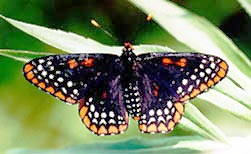|
|
Butterflies Lost & Found
Read on if you love a good mystery
by Steve Carr
The Baltimore (aka the Baltimore checkerspot) is the Maryland state butterfly. It’s a small little bugger with the distinctive black and orange colors of Lord Baltimore’s family crest. Back in the ’50s, when the General Assembly designated the Baltimore checkerspot as Maryland’s official butterfly, there were lots of Baltimores flitting about the state. Such is not the case today. In fact, you have almost as good a chance of seeing a Baltimore checkerspot as you do of spotting an emperor penguin.
All those subdivisions where there used to be farms and grassy fields have swallowed up much of the Baltimore’s home. The Baltimore, like many butterflies, is dependent upon one particular plant for its survival. And when that plant vanishes, so goes the butterfly. The Baltimore needs the turtlehead plant. Turtleheads are native to wetland areas and have almost vanished because of sprawl development, the invasion of exotic species and browsing deer.
There’s a lady in D.C. named Pat Durkin, who heads the Washington Area Butterfly Club, and she has convinced some of her friends to start growing turtlehead so that it can be transplanted around Maryland. Pat’s goal is to bring back the Baltimore by first bringing back the turtlehead. No one has the foggiest idea whether this will work, but it’s worth a shot.
 |
Baltimore checkerspot.
photo by Mark Garland
|
If reintroduction proves successful, we can try it with some of the other butterflies that have disappeared from the local landscape. The gold-banded skipper, which depends on the hog peanut, and the regal fritillary, which is partial to certain violets, haven’t been seen in Maryland in a decade. The only remaining place east of the Mississippi where the fritillary still can be found is a tiny military base in Pennsylvania, and that site is currently under seige.
There are about 150 species of butterfly in Maryland, and nearly 90 call Anne Arundel County their home.
Like house sparrows, some butterflies have adapted quite well to human development. My buddy Hal Wierenga, affectionately known as Mr. Butterfly, calls these the “garbage butterflies.” The cabbage white heads this list. It is a non-native exotic that flourishes almost anywhere. While they are pretty to watch, they are in fact indicative of an environment out of balance.
I met with Hal the other day over a beer and asked him to explain the wonderful world of butterflies to me.
Butterfly Basics
“The first thing you need to remember about butterflies,” said Hal, “is they are genetically programmed to eat and mate. That’s it. They only live for a few weeks, and their life on earth is spent passing on their genes to the next generation.”
Butterflies lay their eggs on their favorite plant. The egg hatches within a week and turns into a caterpillar, which chows down on its host plant for the next few weeks. As it grows, it continually sheds its skin like a snake. Once it reaches maturity, it attaches itself to its favorite plant and begins forming a chrysalis — a sort of protective shell around itself, made from its own body fluids. From the inside of this magical spit-house, a butterfly eventually emerges.
But here’s the thing that you need to remember: When you see a butterfly, chances are it’s going to be gone in a few short days or weeks. Gone as in dead. During the warmer months of the year, you have this constant cycle of eggs into caterpillars into butterflies, like a cosmic conveyor belt that just keeps cranking out more and more butterflies.
Butterflies in Winter
“But what happens to the butterflies in winter?” I asked Hal. “Don’t they all freeze? Or do they migrate south like birds?”
“Well now, that’s where it gets a bit tricky,” said Hal. “At some point in the fall, when it starts getting colder, many butterflies lay their eggs in the usual way, and they remain unhatched for the whole winter. Others hatch out and then put on their chrysalis coats and go dormant. They attach themselves to some inconspicuous spot — often the underside of a leaf — and then hibernate until spring.”
Hal held up his finger to make his next point. “But some of the really hardy butterflies actually overwinter as adults here in Maryland. Butterflies, such as the question marks and commas, must have antifreeze in their systems because they manage to make it through our deep freeze winters. They crawl under the shaggy bark of trees like hickories when it’s cold and then fly around when it warms back up. Those are the butterflies you see on a 50-degree February day.”
Any story about butterflies invariably leads to the Monarch. Because when all is said and done, they are the only ones that most people can recognize.
Monarchs are making their amazing southern migration right now. Millions of them are working their way down to Mexico where there are two gigantic roosts. Hal told me that he and some friends banded nearly 100 of them last month on Greenbury Point, near Annapolis.
“Banded”? I asked. “How the heck do you band a butterfly?”
Hal chuckled. “First, you catch ’em in a net. Then, you scrape off the scales near the center of one of their wings. That’s so you can stick a numbered tag there for future identification.”
“Get out,” I said with disbelief.
“I kid you not,” insisted Hal. “I tagged a monarch last year in my back yard in Arnold, and it was found down in El Rosario, Mexico, a few months later. The ID numbers are sent to the University of Kansas, and all the butterfly trackers around the world tap into that registry.”
The monarch story sounds more like science fiction than fact. They leave Mexico in March and head for Texas — where they die, but not before laying the next generation’s eggs. The offspring fly a few states north and repeat the cycle every few weeks until they have populated most of the United States. For some inexplicable reason, probably triggered by the shorter days of fall, the final generation of the year start heading south to Mexico near the end of September, rather than breed and hatch the next brood. Curiously enough, these monarchs will live for the next six months, enabling them to fly almost 2,000 miles through all sorts of wind and weather, covering almost 50 miles a day, until they arrive at their wintering grounds, where they mass together for warmth in the fir forests near Mexico City.
“But they are six generations removed from the monarchs that left Mexico in March,” I reminded Hal. “How could they possibly know how to go back to the same place? And why do they live so long?”
Hal shook his head and ran his finger around the rim of his glass. “That’s one of the world’s great mysteries.”
Don’t you just love a good mystery?
About the Author:
Steve Carr owns an environmental consulting business and is a past president of the Severn River Association. An avid birder who enjoys canoeing, hiking and bicycling, he has written extensively about the Bay for many years and has lived along the Severn River his whole life. |
 |
Copyright 2002
Bay Weekly
|